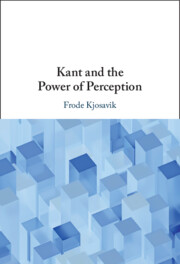Refine search
Actions for selected content:
1686 results
Chapter 4 - Reason’s Supreme Principle, the Principle of Sufficient Reason, and the Faculty of Reason
-
-
- Book:
- The Aristotelian Kant
- Published online:
- 15 December 2025
- Print publication:
- 22 January 2026, pp 92-124
-
- Chapter
- Export citation
Chapter 5 - Form and Matter in Kant’s Account of Self-Consciousness
-
-
- Book:
- The Aristotelian Kant
- Published online:
- 15 December 2025
- Print publication:
- 22 January 2026, pp 125-147
-
- Chapter
- Export citation
Failure of a single performance validity test matters after traumatic brain injury
-
- Journal:
- Journal of the International Neuropsychological Society , First View
- Published online by Cambridge University Press:
- 18 December 2025, pp. 1-6
-
- Article
- Export citation
Validation of the Sydney Language Battery naming subtest and utility of latency analysis in characterizing language impairment in multiple sclerosis
-
- Journal:
- Journal of the International Neuropsychological Society , First View
- Published online by Cambridge University Press:
- 11 December 2025, pp. 1-8
-
- Article
-
- You have access
- Open access
- HTML
- Export citation
Chapter 5 - Neurotransmitters and Neuromodulators in Dementia
- from Section 1 - Introductory Chapters on Dementia
-
-
- Book:
- The Behavioral Neurology of Dementia
- Published online:
- 17 November 2025
- Print publication:
- 11 December 2025, pp 75-86
-
- Chapter
- Export citation
Memory processes in schizophrenia: impact of comorbidity with substance use disorders
-
- Journal:
- Irish Journal of Psychological Medicine , First View
- Published online by Cambridge University Press:
- 11 December 2025, pp. 1-8
-
- Article
- Export citation
Medication and atypical brain maturation in psychosis associated with long-term cognitive decline and symptom progression
-
- Journal:
- The British Journal of Psychiatry , FirstView
- Published online by Cambridge University Press:
- 11 December 2025, pp. 1-11
-
- Article
-
- You have access
- Open access
- HTML
- Export citation

Creative Construction Grammar
-
- Published online:
- 05 December 2025
- Print publication:
- 08 January 2026
-
- Element
-
- You have access
- Open access
- HTML
- Export citation
Cracking under pressure: Cognitive load influences performance in youth with NF1
-
- Journal:
- Journal of the International Neuropsychological Society , First View
- Published online by Cambridge University Press:
- 01 December 2025, pp. 1-8
-
- Article
-
- You have access
- Open access
- HTML
- Export citation
Failure to account for psychiatric symptoms: Implications for the replicability and generalizability of psychological science?
-
- Journal:
- Psychological Medicine / Volume 55 / 2025
- Published online by Cambridge University Press:
- 01 December 2025, e367
-
- Article
-
- You have access
- Open access
- HTML
- Export citation

Kant and the Power of Perception
-
- Published online:
- 27 November 2025
- Print publication:
- 11 December 2025
Stereotypes as mnemonic frames: How journalism mediates collective memory in representations of foreign groups
- Part of
-
- Journal:
- Memory, Mind & Media / Volume 4 / 2025
- Published online by Cambridge University Press:
- 25 November 2025, e25
-
- Article
-
- You have access
- Open access
- HTML
- Export citation
Metabolic considerations for cognitive modeling
-
- Journal:
- Behavioral and Brain Sciences / Accepted manuscript
- Published online by Cambridge University Press:
- 18 November 2025, pp. 1-53
-
- Article
-
- You have access
- Export citation
Longitudinal neurocognitive outcomes in children with mild traumatic brain injury: An ABCD cohort analysis
-
- Journal:
- Journal of the International Neuropsychological Society / Volume 31 / Issue 9-10 / November 2025
- Published online by Cambridge University Press:
- 14 November 2025, pp. 646-655
-
- Article
- Export citation
Heterogeneity of brain functional connectivity, transcriptome, and neurotransmitter profiles in major depressive disorder
-
- Journal:
- Psychological Medicine / Volume 55 / 2025
- Published online by Cambridge University Press:
- 12 November 2025, e341
-
- Article
-
- You have access
- Open access
- HTML
- Export citation
Understanding mental fatigue after subarachnoid hemorrhage: A focus on processing speed, attentional control, and psychological distress
-
- Journal:
- Journal of the International Neuropsychological Society / Volume 31 / Issue 9-10 / November 2025
- Published online by Cambridge University Press:
- 07 November 2025, pp. 670-677
-
- Article
-
- You have access
- Open access
- HTML
- Export citation
Characterising negative symptoms in schizophrenia: CHANSS study protocol
-
- Journal:
- BJPsych Open / Volume 11 / Issue 6 / November 2025
- Published online by Cambridge University Press:
- 06 November 2025, e269
-
- Article
-
- You have access
- Open access
- HTML
- Export citation
Focused and automatic subtypes of skin picking disorder
-
- Journal:
- CNS Spectrums / Volume 30 / Issue 1 / 2025
- Published online by Cambridge University Press:
- 05 November 2025, e91
-
- Article
-
- You have access
- Open access
- HTML
- Export citation

Cognition and Conspiracy Theories
-
- Published online:
- 03 November 2025
- Print publication:
- 04 December 2025
-
- Element
- Export citation
Independent versus joint effects of polygenic or family-based schizophrenia risk in diverse ancestry youth in the ABCD study
-
- Journal:
- Psychological Medicine / Volume 55 / 2025
- Published online by Cambridge University Press:
- 30 October 2025, e327
-
- Article
-
- You have access
- Open access
- HTML
- Export citation
